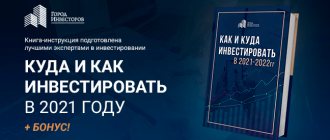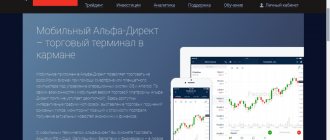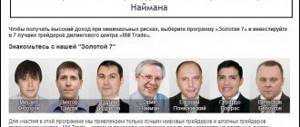Properly placed funds bring passive income to their owner. This is a reliable way not only to save your earned money, but also to increase it by investing in profitable and promising enterprises. However, a lot of obstacles arise on the path of a novice investor in the form of unfamiliar terms and concepts. This is an important point, because without a correct understanding of the terminology it is impossible to master the basics of investing.
The first concept you need to understand is an investment portfolio.
This is the basic term around which the entire system of designations and names revolves.
Forming a portfolio of securities is the first step in investing, on which success and the amount of income depend. This is an important step that determines all the parameters or conditions for investing funds. It is difficult to do it without preliminary preparation. Without knowing what an investment portfolio is and what it is needed for, it is impossible to wisely place money and make a profit.
Before creating an investment portfolio, you need to carefully study the issue, understand its features and specifics. Forming a portfolio of securities is a task that requires an understanding of the relationship between the elements of the investment procedure. It is necessary to understand their features, master the classification of investment portfolios, and decide on your preferences.
Investment of funds will give the expected result only if used correctly; you cannot act at random here.
Let's take a closer look at how to make investments correctly to get maximum income. We will study the features, methods of forming a portfolio of securities, pros and cons, rules, options for competent actions.
What is an investment portfolio
Investing is a reliable way to invest funds to protect against inflation and generate passive income.
The principle of this action is not difficult - money is invested in securities that maintain or increase in value. However, it will not be possible to generate income by arbitrarily purchasing shares and counting on profit. The problem is liquidity, changes in market conditions, external factors. Therefore, for a novice investor, the first step is to study the market situation and select the most promising instruments. Then an investment portfolio is formed.
The basic rule of business is to divide funds into independent parts. If some amount is not used rationally and does not bring profit, losses can be compensated with the help of other parts. An investment portfolio is, in simple words, a set of instruments (securities) in which funds will be invested. That is, the investor does not buy shares of one type, but purchases several varieties in order to protect against losses. Thus, the rule of minimizing financial risks is observed when funds are distributed among individual positions.
An investment portfolio is a collection of securities purchased for a specific purpose.
This may be making a profit or holding money in another form to protect capital from inflation. A correctly formed set will allow you to reduce financial risks and avoid losses from external causes, which increase many times over when purchasing one large package of securities.
Before we begin to consider the principles of forming an investment portfolio, we need to decide on the participants in the process.
It is necessary to separate two concepts:
- Investor. This is a person who wants to invest in the purchase of securities in order to protect against inflation and make a profit. There are active investors who constantly monitor dynamics and adjust their investments in more promising instruments. Passive investors do not monitor market conditions, relying on the reliability of the purchased securities;
- Trader. This is a person for whom making money on the stock exchange becomes his main occupation. He makes a lot of transactions every day, making money on increases or decreases in stock prices. Uses your own funds or borrows from a broker. Unlike an investor, a trader acts much more intensively, which is reflected in his income.
The difference between traders and investors is great. Sometimes they are considered opposites.
A trader is a speculator (without a negative connotation) who makes money by buying and quickly reselling securities.
An investor invests funds in anticipation of long-term dividend income, or for safety, protection from inflation or devaluation.
For any participant in the process, it is important to choose the right set of tools that will bring maximum profit without losses. The structure of an investment portfolio is a separate and complex issue, since the amount of profit and the reliability of investments depend on the composition of securities. It is difficult for an inexperienced person to determine which assets are more profitable or stable, since they have to take into account a lot of influencing factors.
Important! Trading is an activity, but it is suitable for inexperienced, beginner participants. Here you need to have a clear understanding of the essence of the processes, see trends and respond in time to signs of an increase or decrease in the positions of securities. Passive investing is suitable for beginners until they gain sufficient experience and skills in using the tools.
Rule #4. Think ahead
As Warren Buffett said, if you don't plan to hold a stock forever, it's best not to buy it. What follows this rule:
- A long-term investor’s portfolio should not include “fashionable” stocks with exorbitant P/S and P/E indicators (many stocks from NASDAQ, including the beloved Apple, are guilty of this - the latter’s P/S goes beyond 50, i.e. e. the company will pay for itself in 50 years);
- The first purchase should be made at the bottom of the stock price, i.e. you need to choose undervalued stocks with growth potential;
- to build up your portfolio, it is better to use an averaging strategy - this way you can buy shares at the median price over the course of a year;
- preference should be given to dividend stocks - I have a review of the US dividend aristocrats and the most profitable stocks in Russia in terms of dividends.
In general, it is better to buy assets for several years. Another advantage of this approach is that you will save on taxes. For example, if you own shares of mutual funds for more than 3 years, then you will not need to pay personal income tax on profits. The same goes for stocks.
What is a portfolio made of?
An investment portfolio (sometimes another name is used - an income portfolio, a not very precise, but expressive term) is made up of a set of securities that show positive dynamics at the moment or in the future.
When forming a securities portfolio, any instruments can be used:
- OFZ (federal loan bonds). This is a reliable way to save and increase funds. Bond yields are relatively low, but profits are not subject to personal income tax, and there are no losses when using OFZs;
- company bonds. These are debt obligations of private or public companies. The income from them is higher than from OFZs, but there is a risk of loss of funds due to the bankruptcy of the company during the validity period of the bonds;
- stock. An investor, by purchasing them, becomes the owner of a part of the company, having the right to participate in management and receive dividends. Here you can get high profits, but the risk is also higher than when using other instruments;
- bank deposits. These are deposits placed for a predetermined period at a fixed percentage of profit. The advantage of this method is the protection of deposits - they are insured for an amount of no more than 1.4 million rubles. If you need to deposit an amount exceeding the insurance maximum, you should divide the money and deposit it in different banks;
- options, futures. These are documents confirming the right to purchase assets at a specified time or for an indefinite period. Such securities are in high demand and liquidity, but the risk of losing funds when dealing with them is quite high. For inexperienced investors, dealing with options or futures is not recommended, as there is a high possibility of losing funds;
- precious metals. This is a traditional way to preserve or increase capital;
- real estate, other assets.
It is necessary to understand that the formation of a securities portfolio requires accurate knowledge of the dynamics of growth or decline of each instrument. Lack of detailed information can cause serious, sometimes fatal errors. You can’t act at random; there are no random luck here. It is important to choose instruments wisely, distribute them proportionally according to the degree of risk and profitability.
Before forming an investment portfolio, it is necessary to study the trends in price movements for assets of various types and identify the most promising instruments. This is a difficult task that even experienced exchange players do not always cope with successfully. Therefore, for a novice investor, the right decision would be to entrust the formation of a securities portfolio to experienced, professional participants - trust managers or brokers.
Rule #7. Stick to the routine
Regardless of the chosen strategy, you need to adhere to the selected portfolio construction plan. If you constantly deviate from it, then there will be no benefit from such investments.
For example, an investor decided to purchase 10 shares of MTS, 10 shares of Sberbank and 10 shares of AFK Sistema. Every month he buys 1 share of each issuer. Thus, in less than a year he will reach his goal.
In filling a portfolio, systematicity and consistency are important. And then compound interest begins to work.
Types of investment portfolios
Creating a balanced portfolio is not easy.
You need to be aware of the current market situation, know the general dynamics and trends in changes in securities positions. This requires experience, an intuitive understanding of possible situations, and anticipation of changes due to external factors. The very point of creating a portfolio is to distribute available funds across sectors or positions in order to obtain maximum profits and minimum losses.
The composition of the portfolio is determined by the degree of preparation and personal qualities of the investor. People with an adventurous mindset often take risks, choosing instruments with maximum profit, but with high risks. More prudent and cautious investors prefer instruments with low returns, but reliable and guaranteed against losses. The choice of one type or another depends on the investor’s temperament and experience. There are different types of investment portfolios, which are conventionally grouped according to certain characteristics.
For example, according to the level of risk there are:
- aggressive. This is a portfolio that contains risky and high-yield securities that require constant monitoring and attention. These include futures and options, high-yield shares of rapidly growing companies, and high-yield bonds. This portfolio is not suitable for novice investors;
- moderate. A set of securities that provide an average level of profit. This package is more reliable and does not threaten the loss of funds in full. As a rule, it consists of bonds, shares and shares of mutual funds;
- conservative. It is built with the goal of preserving funds and protecting them from inflation. This includes deposits in banks of the highest level of reliability, OFZ or precious metals. In this case, one cannot expect significant profits, but investors do not have such a goal.
By method of making profit:
- growth portfolio. Consists of stocks or bonds that increase in value;
- dividend portfolio. Designed to receive dividends from shares of promising enterprises.
The first type is classified as active, and the second - passive types of income.
By speed of profit generation:
- short. Designed for quick income from the sale of assets with high liquidity (stocks, federal loan bonds, deposits, etc.);
- long-term. This is a portfolio that is filled with securities of different levels of risk and profitability. The expectation is to receive constant profits and the ability to compensate for losses on risky securities at the expense of less profitable but stable assets.
The choice of a suitable set of securities is determined by the personal qualities and financial capabilities of the investor. In addition, an important factor is the goal or objectives that the investor sets for himself. If you need to preserve existing capital, choose reliable options that are free of financial risks. Risky but profitable operations are suitable for making quick money. It is not recommended to invest large sums here; it is better to distribute them over several positions to reduce the risk if an unfavorable situation arises.
Rule #3. Compare profitability with benchmark
In order to understand what the profitability of your portfolio is, you need to compare it with some indicator. Which one exactly depends on the asset structure. For example, if you invest mainly in Russian stocks, then compare with the Moscow Exchange or RTS index. If you buy shares of American companies, use the Nasdaq or the S&P index. Bonds also have their own benchmarks.
But in general, the expected return on an investor’s portfolio is 20% per annum. I believe that we need to strive for this indicator. Naturally, for a conservative portfolio, 15% is an excellent result. But if you take a balanced portfolio, then 20% is just right as a guideline.
How to create an investment portfolio
Proper formation of a securities portfolio is the key to success, making a profit, or at least saving money from fluctuations in the economic situation.
The stock market offers a lot of tools that give the desired results. However, if the actions turn out to be erroneous, the consequence will be partial or complete loss of the invested money or other assets. Investing is a process designed for long-term action, where fluctuations in profitability and temporary changes in the situation are possible. It is impossible to completely eliminate errors, but you can reduce their consequences.
Formation of a securities portfolio requires the participant to choose the right strategy. It is necessary to decide on the nature of the operations and choose the method of generating income. First of all, you need to decide whether to engage in investing or trading activities. This is an important point that determines the nature and duration of the operations performed. If an investor expects long-term and stable profits from receiving dividends, then the trader makes money on local exchange rate fluctuations, performing a lot of operations in a short period of time.
The next step is to select the tools. Inexperienced participants are not advised to immediately consider risky or unfamiliar positions. This is dangerous, since such papers are affected by a lot of external factors. They are difficult to calculate, and the risk of making mistakes increases. Even experienced investors often lose money due to unforeseen circumstances - political events or natural disasters that cause the value of stocks, bonds or other securities to fall.
If you decide to purchase risky assets, you should balance them with more reliable and stable securities. Here it is important to determine the amount of portfolio drawdown (allowable losses) and its horizon (duration of investment). In order to be able to withdraw money from an individual investment account (IIA), it takes 3 years. For a novice investor, it is recommended to choose a horizon that corresponds to this period. It is considered medium, not too long, but not small either.
The shorter the horizon, the higher the aggressiveness of the portfolio can be. As the duration increases, the number of probable losses increases, which makes the formation of a portfolio of securities with increased risks impractical. It is important to carry out competent diversification and reduce risks as much as possible. It is necessary to use several positions that balance each other in terms of reliability and profitability. Some securities should generate income, while others should provide compensation in the event of sharp drawdowns in individual sectors.
A thorough analysis should be carried out for each instrument.
All positions affecting the income side are considered:
- marginality (profit received after selling products minus variable costs);
- dividend yield (dividend amount;
- FCF, or free cash flow;
- the company's net debt, which determines the amount of deductions;
- capex, or capital expenditure (an indicator of a company's expenditure on improvement, construction of infrastructure).
The combination of these indicators is subject to in-depth analysis, based on the results of which a choice is made.
The finished portfolio must be constantly checked and weak positions strengthened. If unprofitable assets are discovered, they are sold and replaced with more reliable, profitable securities. Even if a portfolio is created to store capital or protect funds from depreciation, it will have to be regularly monitored and optimized. Otherwise, you may end up losing big.
Rule #10. Don't try to speculate on news and don't sell on emotions
When assembling an investor's portfolio in 2021, it's easy to be tempted to buy well-known and trendy stocks. Or, on the contrary, shares of Nizhnekamskneftekhim, which pays simply astronomical dividends (why this needs to be done carefully - I talk about the dividends of NKNK in the article).
And at the same time, you can ignore stocks that are undervalued or fairly valued by the market, but are too “boring.” But John Bogle always said that you need to invest in a boring and predictable business with a clear operating model.
Now you know the basic rules for forming an investor's portfolio. But this is only the most basic knowledge. If you want to learn how to assemble a truly profitable and balanced portfolio that will help you achieve your goals and objectives, welcome to study the course “How to create your own investment portfolio.” I generously share the knowledge necessary for investment success. Good luck, and may the money be with you!
Rate this article
[Total votes: 1 Average rating: 5]
Pros and cons of an investment portfolio
An investment portfolio has a lot of advantages and disadvantages.
The advantages include:
- opportunity to get high profits. The profitability of an investment portfolio, with proper formation and a successful combination of circumstances, is not limited by any factors;
- the liquidity of the securities collected in the portfolio allows them to be easily sold or exchanged for other assets;
- reliability, protection of funds from external influences. The securities in the portfolio are diversified, which increases their resistance to price fluctuations or stock market problems. This distinguishes a set from a single package of papers;
- ease of operation. This is a conditional advantage, since there are no simple moments for novice investors. However, with experience, actions and control over the portfolio become significantly easier;
- useful experience in dealing with securities. The skills of using the stock market to solve financial issues often become more valuable than the assets themselves. It is more profitable to learn how to increase capital than to save the amount received.
Most novice investors value reliability and safety of assets. However, as experience becomes available, storage alone becomes insufficient; an increase and growth of assets is required. Investors are beginning to increase their use of risky, high-yield securities.
At this stage, disadvantages appear:
- high investment risk. Here, the disadvantages are present initially, since there is no complete guarantee against losses;
- the need for a thorough analysis of the market situation, study of market conditions, and study of dynamics. It is possible to form an optimal investment portfolio only after a comprehensive study of all aspects of the stock market. This requires time, perseverance and ability to analyze the situation;
- We need the ability to forecast and foresee the market situation. Hard work and diligence are not always enough here. Experienced investors often claim that their actions are guided by a special instinct, developed over years of work on the stock exchange.
Important! The advantages and disadvantages of an investment portfolio are relative categories. With the advent of experience, attitudes towards many aspects change; apparent disadvantages are perceived only as specific features.
Examples
Building a balanced investment portfolio is a real skill. Let's look at it using the most successful examples from the Yammi service.
An example of a model balanced portfolio from the Yammi service in 2021:
- The investment amount is 100,000 rubles.
- Risk profile: moderate
- Investment horizon 2 years
- Expected return: 12% per annum
- Composition: FXGD ETF for gold (8.84%), FXRW - global market shares with ruble hedge (86.16%), FXRB (ETF for Eurobonds (5%)
Example of a conservative portfolio:
- Risk level: low
- Investment amount: 500,000₽
- Expected return: 6.02% per annum
- Investment horizon: 5 years
- FXMM (money market fund) (63.97%)
- FXRW (global market shares) - 17.02%
- FXRB (Eurobond fund) - 16.03%
- FXGD (gold ETF) - 2.98%
Markowitz theory
Nobel laureate Markowitz proposed the theory of the investment portfolio back in 1952. It continues to remain relevant today. It helps to assemble an optimal portfolio of assets based on the required ratio between risk and return parameters. Here the investor solves two goals:
- how to maximize profitability for a given risk;
- how to minimize risk with the minimum acceptable return.
Profitability is the weighted average sum of the returns of the assets included in its composition. The risk of an instrument is the standard deviation of its return.
To assess the overall risk of an investment portfolio, you should calculate the total change in the risks of individual assets and their mutual influence.
Markowitz's theory led investors to pay more attention to the interconnectedness of assets. If you build your portfolio correctly, you can reduce risks due to the inverse correlation of instruments.
Now you don’t need to calculate anything yourself. For example, Roger Gibson provides examples of how computer calculations can help optimize an investment portfolio. There are special services for this, for example Yammi.
More about the news
The most important and significant news feeds, which contain information about the results of active work, mergers and the conclusion of life-changing contracts, enter the stock market through official channels. In England, this issue is supervised by RNS , the information collection and regulation department owned by the London Stock Exchange. In the United States of America, this is handled by the SEC - securities and exchange management. Experts at these companies disseminate data on which investors make decisions. News feeds that influence stock prices and press releases are the main vectors of information that should be relied upon in analytical work with the subsequent adoption of the only true and correct decision.
Unfortunately, the official source is the peak of the Empire State in New York. Ordinary investors do not have access to 150 floors crammed with information. However, this does not mean that important information is always hidden.
It is distributed by public relations firms and organizations that investors trust as themselves. Specialists of these companies organize the provision of information to analysts and investors, who, in turn, process the information during periods between news feeds.
A little history
Reporters and managers of large investment centers appeared many decades ago. The analyst profession is a relative innovation. In America, analysts began to work fruitfully at the peak of Wall Street's glory, which occurred in the 20s of the 20th century. At that time, the position of analyst was held by specialists from the information collection and processing department. On the London Stock Exchange, the first analytical studies began to be carried out in the 60s of the twentieth century . Their audience grew as the number of brokerage firms and investment vector companies increased. Later, organizations specializing in management activities in the field of investment projects began to open their own departments for analytics and processing information channels.
The job of a stock market analyst is to develop investment recommendations that are then used by clients and employers. Today, working at the NYSE is prestigious and respected.
Management stages
- Planning in the relationship between different assets, involving the identification of securities of a conservative or aggressive type, followed by the correct choice of an option that satisfies the investor with interest;
- Drawing up a pool of investment instruments , which is based on an analysis of the level of profitability and degree of risk for the securities in question;
- Regular market monitoring with assessment of value, corresponding reaction to changes in the price of a separate part of the portfolio.
IIS
You can get additional benefits from investing in OFZs by purchasing government bonds using an individual investment account. You will be able to receive a tax deduction for the amount deposited (provided that you paid personal income tax).
For example, if you have collected a portfolio worth 100 thousand rubles, you can return 13% of this amount from the state - namely 13 thousand rubles. Consider it an increase in investment income.
I wrote more about the implementation of the scheme and its limitations in this article.
Portfolio to receive 10 thousand rubles per month
Let's calculate what bonds you will need and in what quantity if you want to receive a fixed income of about 10 thousand rubles per month. The set is still the same, but the numbers are different:
| Bond name | maturity date | Coupon size | Buy pieces | Purchase amount |
| OFZ 26224 | 23.05.2029 | 34.41 ? | 291 | 283 745.37 ? |
| OFZ 26212 | 19.01.2028 | 35.15 ? | 285 | 274 129.82 ? |
| OFZ 26207 | 03.02.2027 | 40.64 ? | 247 | 270 383.98 ? |
| OFZ 26219 | 16.09.2026 | 38.64 ? | 259 | 267 167.31 ? |
| OFZ 26221 | 23.03.2033 | 38.39 ? | 261 | 267 178.13 ? |
| OFZ 26225 | 10.05.2034 | 36.15 ? | 277 | 251 918.20 ? |
To achieve the goal you will need 1,614,522.81 rubles. The average profitability is about 10,017 rubles per month.










